 From Mimetic Translation to Artistic Transduction
From Mimetic Translation to Artistic Transduction Published online by Cambridge University Press: 01 March 2024
Exploring New Avenues of Translation
A word of explanation is needed for those readers who have not previously been introduced to the idea of a greater understanding of the evolution of translation into transduction. Transduction is beyond translation: it moves beyond the transferal of one language to another to signify speculative attempts at examining and executing the belief, concepts and meaning of the different arts. The art of translating means engaging in the analytical exercise of transferring, rotating and twisting one language into another art; but for literary translation, the objective of retranslation or self-translation is to create through translation the poetic and lyrical terms of transduction, which is the main concept discussed in this book.
Translation (including retranslation and self-translation) seems to be an ancient and contemporary process of attempting to unite science and art in order to communicate information through incomplete changes and reforms of coded language determined in space or time. In today’s world, an understanding of human culture can expand translation into the unexpected force linguistic retranslation into coded and uncoded music, conveying the “expressive melody, the rhythmic experimentation, the coloristic use of harmony and instrumental timbres, [and] the relaxation of and uncertainty about formal canon” (Longyear 1969, 3). The extension of translation over the ages is called transduction, which concerns the “arts of incompletion” (Bernhart and Englund 2021) of words-and-music as illustrated and exemplified in the present book From Mimetic Translation to Artistic Transduction: A Semiotic Perspective on Virginia Woolf, Hector Berlioz, and Bertolt Brecht.
Transduction expands informational (that is, highly meaningful) language into an inventory of the literary dialects, idioms and jargons of other fine and applied arts. To judge the evolution of translation to transduction, if the operational conclusion arising from the evidence introduced in the examples of this book is a true metaphor, Peirce’s “interpretants” in transduction can signify that the details of the artistic signs are not necessarily seen as harsh and static target units but are sent forth in the fluid patterns given to received source signs. Peirce’s interpretants are called “reactor” signs, explained in terms of the stimuli, responses, needs and satisfaction of the categories of the source sign (Sebeok 1994/1999, 64–65).
To save this book to your Kindle, first ensure [email protected] is added to your Approved Personal Document E-mail List under your Personal Document Settings on the Manage Your Content and Devices page of your Amazon account. Then enter the ‘name’ part of your Kindle email address below. Find out more about saving to your Kindle.
Note you can select to save to either the @free.kindle.com or @kindle.com variations. ‘@free.kindle.com’ emails are free but can only be saved to your device when it is connected to wi-fi. ‘@kindle.com’ emails can be delivered even when you are not connected to wi-fi, but note that service fees apply.
Find out more about the Kindle Personal Document Service.
To save content items to your account, please confirm that you agree to abide by our usage policies. If this is the first time you use this feature, you will be asked to authorise Cambridge Core to connect with your account. Find out more about saving content to Dropbox.
To save content items to your account, please confirm that you agree to abide by our usage policies. If this is the first time you use this feature, you will be asked to authorise Cambridge Core to connect with your account. Find out more about saving content to Google Drive.